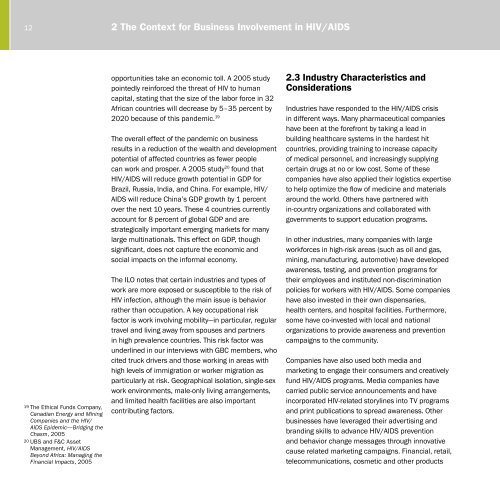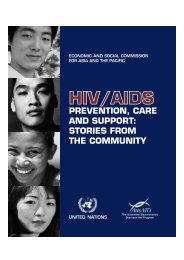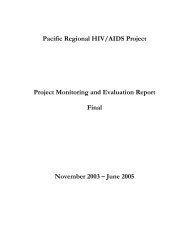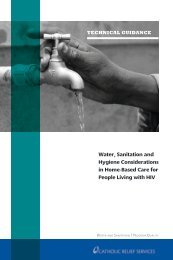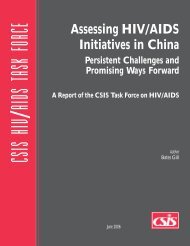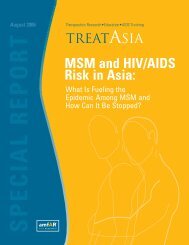The State of Business and HIV/AIDS (2006) - Booz Allen Hamilton
The State of Business and HIV/AIDS (2006) - Booz Allen Hamilton
The State of Business and HIV/AIDS (2006) - Booz Allen Hamilton
You also want an ePaper? Increase the reach of your titles
YUMPU automatically turns print PDFs into web optimized ePapers that Google loves.
12<br />
2 <strong>The</strong> Context for <strong>Business</strong> Involvement in <strong>HIV</strong>/<strong>AIDS</strong><br />
19 <strong>The</strong> Ethical Funds Company,<br />
Canadian Energy <strong>and</strong> Mining<br />
Companies <strong>and</strong> the <strong>HIV</strong>/<br />
<strong>AIDS</strong> Epidemic—Bridging the<br />
Chasm, 2005<br />
20 UBS <strong>and</strong> F&C Asset<br />
Management, <strong>HIV</strong>/<strong>AIDS</strong><br />
Beyond Africa: Managing the<br />
Financial Impacts, 2005<br />
opportunities take an economic toll. A 2005 study<br />
pointedly reinforced the threat <strong>of</strong> <strong>HIV</strong> to human<br />
capital, stating that the size <strong>of</strong> the labor force in 32<br />
African countries will decrease by 5–35 percent by<br />
2020 because <strong>of</strong> this p<strong>and</strong>emic. 19<br />
<strong>The</strong> overall effect <strong>of</strong> the p<strong>and</strong>emic on business<br />
results in a reduction <strong>of</strong> the wealth <strong>and</strong> development<br />
potential <strong>of</strong> affected countries as fewer people<br />
can work <strong>and</strong> prosper. A 2005 study 20 found that<br />
<strong>HIV</strong>/<strong>AIDS</strong> will reduce growth potential in GDP for<br />
Brazil, Russia, India, <strong>and</strong> China. For example, <strong>HIV</strong>/<br />
<strong>AIDS</strong> will reduce China’s GDP growth by 1 percent<br />
over the next 10 years. <strong>The</strong>se 4 countries currently<br />
account for 8 percent <strong>of</strong> global GDP <strong>and</strong> are<br />
strategically important emerging markets for many<br />
large multinationals. This effect on GDP, though<br />
significant, does not capture the economic <strong>and</strong><br />
social impacts on the informal economy.<br />
<strong>The</strong> ILO notes that certain industries <strong>and</strong> types <strong>of</strong><br />
work are more exposed or susceptible to the risk <strong>of</strong><br />
<strong>HIV</strong> infection, although the main issue is behavior<br />
rather than occupation. A key occupational risk<br />
factor is work involving mobility—in particular, regular<br />
travel <strong>and</strong> living away from spouses <strong>and</strong> partners<br />
in high prevalence countries. This risk factor was<br />
underlined in our interviews with GBC members, who<br />
cited truck drivers <strong>and</strong> those working in areas with<br />
high levels <strong>of</strong> immigration or worker migration as<br />
particularly at risk. Geographical isolation, single-sex<br />
work environments, male-only living arrangements,<br />
<strong>and</strong> limited health facilities are also important<br />
contributing factors.<br />
2.3 Industry Characteristics <strong>and</strong><br />
Considerations<br />
Industries have responded to the <strong>HIV</strong>/<strong>AIDS</strong> crisis<br />
in different ways. Many pharmaceutical companies<br />
have been at the forefront by taking a lead in<br />
building healthcare systems in the hardest hit<br />
countries, providing training to increase capacity<br />
<strong>of</strong> medical personnel, <strong>and</strong> increasingly supplying<br />
certain drugs at no or low cost. Some <strong>of</strong> these<br />
companies have also applied their logistics expertise<br />
to help optimize the flow <strong>of</strong> medicine <strong>and</strong> materials<br />
around the world. Others have partnered with<br />
in-country organizations <strong>and</strong> collaborated with<br />
governments to support education programs.<br />
In other industries, many companies with large<br />
workforces in high-risk areas (such as oil <strong>and</strong> gas,<br />
mining, manufacturing, automotive) have developed<br />
awareness, testing, <strong>and</strong> prevention programs for<br />
their employees <strong>and</strong> instituted non-discrimination<br />
policies for workers with <strong>HIV</strong>/<strong>AIDS</strong>. Some companies<br />
have also invested in their own dispensaries,<br />
health centers, <strong>and</strong> hospital facilities. Furthermore,<br />
some have co-invested with local <strong>and</strong> national<br />
organizations to provide awareness <strong>and</strong> prevention<br />
campaigns to the community.<br />
Companies have also used both media <strong>and</strong><br />
marketing to engage their consumers <strong>and</strong> creatively<br />
fund <strong>HIV</strong>/<strong>AIDS</strong> programs. Media companies have<br />
carried public service announcements <strong>and</strong> have<br />
incorporated <strong>HIV</strong>-related storylines into TV programs<br />
<strong>and</strong> print publications to spread awareness. Other<br />
businesses have leveraged their advertising <strong>and</strong><br />
br<strong>and</strong>ing skills to advance <strong>HIV</strong>/<strong>AIDS</strong> prevention<br />
<strong>and</strong> behavior change messages through innovative<br />
cause related marketing campaigns. Financial, retail,<br />
telecommunications, cosmetic <strong>and</strong> other products


